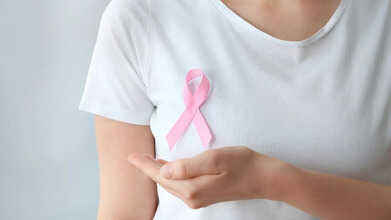- Health Conditions A-Z
- Health & Wellness
- Nutrition
- Fitness
- Health News
- Ayurveda
- Videos
- Medicine A-Z
- Parenting
- Web Stories
Does Meningitis Always Cause Fever?

Image Credit: Canva
Meningitis is a serious medical condition that affects the protective membranes covering the brain and spinal cord, the meninges. While fever is not always present, it is usually considered as one of the classic symptoms of meningitis. It is important to know the varied symptoms, causes, and treatments of meningitis for early diagnosis and proper management of the disease.
Meningitis is an infectious illness that brings about inflammation in the meninges. The most common cause of such inflammation is bacterial or viral infections, though other causes are also possible including fungal, parasitic, or non-infectious causes (autoimmune disease, head injury, or brain surgery). Meningitis may be caused by bacterial meningitis, which the Centers for Disease Control and Prevention (CDC) indicates can be so severe and bring about conditions like hearing loss, vision problems, and death if not received on time.
Does Meningitis Always Result in Fever?
Although fever is a common presentation of meningitis, it is not always present. Certain people, particularly those with compromised immune systems, newborns, or the elderly, can get meningitis without significant temperature elevation. In these instances, other signs such as headache, confusion, or stiff neck can be more suggestive symptoms of the disease.
Fever in meningitis is usually caused by the body's immune reaction to the infection, but some factors can affect its occurrence or absence, such as:
- The nature of meningitis (bacterial, viral, fungal, or non-infectious)
- The immune response of the individual
- Pre-existing health conditions
- The course of the disease
Identifying the Symptoms of Meningitis
Meningitis signs may differ based on the reason and severity of infection. Even though fever is a common symptom, it should also be noted for other vital symptoms, which are:
- Severe headache
- Stiff neck
- Photophobia (sensitivity to light)
- Nausea and vomiting
- Confusion or inability to concentrate
- Fatigue or trouble waking up
- Seizures
- Skin rash (in meningococcal meningitis)
Symptoms in infants can be different and also involve excessive crying, irritability, feeding problems, a bulging soft spot (fontanelle) on the head, and unusual lethargy.
Bacterial vs. Viral Meningitis: Major Differences
Meningitis is usually caused by either bacterial or viral infections, with major differences in severity and treatment:
Bacterial Meningitis: Bacterial meningitis is classified as a medical emergency because it has a rapid progression and can produce fatal complications. Streptococcus pneumoniae, Neisseria meningitidis, and Haemophilus influenzae are typical bacteria that cause meningitis.
Viral Meningitis: Viral meningitis, which is caused by enteroviruses, herpes simplex virus, or influenza, tends to be milder than bacterial meningitis and will normally recover by itself within 7–10 days with supportive therapy.
Diagnosing Meningitis
Physicians diagnose meningitis using a combination of clinical presentation, laboratory examinations, and imaging tests. Important diagnostic tests are:
Lumbar Puncture (Spinal Tap): The test is used to harvest cerebrospinal fluid (CSF) to ascertain the presence of infection and inflammation.
Blood Cultures: To determine bacterial infections in the blood.
Imaging (CT or MRI Scans): To exclude other neurological disorders and identify inflammation.
Treatment Options for Meningitis
Treatment for meningitis varies based on the causative factor:
Bacterial Meningitis: Needs urgent hospitalization and intravenous (IV) antibiotics and corticosteroids to limit inflammation and avert complications.
Viral Meningitis: The majority of cases are treated with supportive treatment, such as rest, fluids, and over-the-counter medications for pain. Antiviral drugs are administered in certain cases, e.g., meningitis caused by herpes.
Fungal and Parasitic Meningitis: Treated with antifungal or antiparasitic drugs.
Non-Infectious Meningitis: Treated by addressing the underlying condition, including autoimmune diseases or drug-induced reactions.
Complications and Long-Term Effects
Bacterial meningitis, if left untreated, can cause severe complications, such as:
- Hearing loss
- Seizures
- Cognitive impairments
- Brain damage
- Kidney failure
How to Reduce the Risk of Meningitis?
A number of vaccines prevent bacterial meningitis, drastically reducing the risk of severe infection. Prominent vaccines include:
Haemophilus influenzae type b (Hib) vaccine – Protects against H. influenzae, a leading cause of bacterial meningitis.
Pneumococcal conjugate vaccine (PCV13) – Recommended for infants and older adults to prevent Streptococcus pneumoniae infections.
Meningococcal conjugate vaccine (MCV4) – Protects against Neisseria meningitidis, commonly recommended for adolescents and college students living in dormitories.
Other preventive efforts include good personal hygiene, the avoidance of direct contact with patients with the condition, and immune protection through lifestyle choices.
This Common Pill May Cut Breast Cancer Risk in Women, New Study Finds

Credits: Canva
Scientists have found that a type of morning-after pill may help protect young women from developing breast cancer. The drug, which is already available for free on the NHS, blocks the hormone progesterone and has been shown to trigger changes in breast tissue that make it less likely for cancer to form. One woman who chose to undergo a double mastectomy as a preventive measure says the discovery “offers hope” to others at high genetic risk of the disease.
A team from Manchester University studied 24 women between 2016 and 2019 who were at high genetic risk of breast cancer due to family history. These women, aged between 34 and 44, took ulipristal acetate, and researchers observed that their breast tissue became less dense and less stiff, conditions that make it harder for cancers to grow.
What Is Ulipristal Acetate?
Ulipristal acetate is commonly prescribed as emergency contraception and to treat moderate to severe uterine fibroids. It works by blocking progesterone receptors, delaying ovulation, and altering the uterine lining to prevent pregnancy, as per 1mg.
Earlier research has also shown that triple-negative breast cancer tends to return or spread more quickly than other breast cancer types, especially within the first few years after diagnosis.
Is Ulipristal Acetate A Promising Step Toward Prevention?
Dr Sacha Howell, lead author of the study and Consultant Oncologist at The Christie Hospital in Manchester, said, “Our research shows that progesterone has a vital role in the development of breast cancer among high-risk women. By blocking its effects, ulipristal acetate and similar drugs could serve as effective preventive treatments,” he explained.
The findings suggest that using ulipristal acetate to prevent breast cancer may one day help women at higher risk before menopause.
Currently, these women face only two preventive options: long-term hormone therapy, which can cause side effects like higher blood clot risk and reduced bone density, or preventive surgery to remove part or all of the breasts.
The Need for Better Options
Dr Simon Vincent, chief scientific officer at Breast Cancer Now, which funded the study, said, “We urgently need better preventive treatments that protect both health and quality of life for women at high risk of breast cancer. Repurposing existing medications, like ulipristal acetate, could be a major step forward. Right now, the available options—preventive surgery or hormone therapy can have a serious impact on both the body and emotional wellbeing.”
The study, published in Nature, found that ulipristal acetate reduced the growth of certain breast cells known as luminal progenitors. These cells can develop into triple-negative breast cancer, an aggressive form of the disease that often affects younger and Black women.
Disclaimer: This article is for informational purposes only and should not be taken as medical advice. Always consult a qualified healthcare professional before starting, stopping, or changing any medication or treatment.
Can A Heart Test Reveal Potential Dementia Diagnosis? New Study Shows They Could Reveal Risk 25 Years Earlier

New research suggests there is a strong connection: if your heart health isn't great when you are in your 40s or 50s, you have a higher chance of being diagnosed with dementia much later in life. The study, published in the European Heart Journal, of 6,000 people found those who developed dementia had high levels of a protein called troponin. This protein signals heart muscle damage and showed up in their blood up to 25 years before they were diagnosed with the brain condition. People with high troponin levels were 38% more likely to get dementia.
How Can a Heart Test Reveal Dementia Risk?
Troponin is a chemical that doctors usually look for when they think someone has had a heart attack. However, even if you haven't had a heart attack, high levels of troponin can still mean your heart muscle is being damaged bit by bit over time or isn't working as well as it should.
This damage can hurt the body's blood vessels, which in turn can reduce the amount of vital blood flowing to your brain. The researchers checked health data from a long-running study that followed people for an average of 25 years after they had their heart protein levels tested.
How is Heart and Brain Health Connected?
According to the American Brain Foundation, poor heart health significantly raises your risk for a stroke because arteries supplying the brain can become narrowed by plaque buildup or instantly blocked by blood clots. This damage, called an ischemic stroke, is accelerated by issues like high blood pressure, cholesterol, diabetes, and smoking. Taking care of your heart ensures your brain receives the necessary healthy blood flow.
Keeping your heart and blood vessels healthy also significantly lowers your risk of developing dementia later on. Heart disease is closely linked to memory decline; coronary heart disease alone increases dementia risk by 40%. Managing risk factors like high blood pressure, diabetes, and especially cholesterol is key to protecting your long-term brain health.
Thinking about your brain's blood flow may not be a daily habit, but adopting healthy habits consistently over the long term can make a huge difference. No matter your age, it is never too late to start focusing on improving and protecting your circulatory and brain health.
Can Testing for Heart Diseases Prevent Dementia?
The researchers points out that the damage leading to dementia happens very slowly, over many years. They emphasize that if you manage common problems like high blood pressure in your middle years, you might be able to slow down or even stop the development of dementia, just as you protect yourself from heart problems. The scientists think testing for troponin could eventually become a key part of a doctor's check-up to predict someone's future risk of developing dementia.
Heart Health is Brain Health
Health experts agree that these findings are a strong reminder that the health of your heart and your brain are inseparable. The best ways to protect your brain are the same ways you protect your heart: keep your blood pressure and cholesterol down, exercise regularly, manage your weight, and avoid smoking. Medical foundations are now putting more money into research focused on understanding and preventing this connection, particularly vascular dementia.
These 11 Factors Could Help Diagnose Dementia At An Early Stage, Says Study

A recent study has listed 11 risk factors that could reveal your risk of developing dementia. As you may know, dementia affects millions of people throughout the world. According to the World Health Organization in 2021, 57 million people worldwide lived with dementia, and about 60% of them lived in low- or middle-income countries.
Dementia, like many other conditions, does not have a cure, so its treatment involves delaying the onset of symptoms. The best way to ensure the symptoms stay under control is by getting an early diagnosis. However, the visible effects of conditions like dementia take a long time, they only become obvious when the disease has affected your body for a long time.
With the help of these risk factors, published in the BMJ Mental Health, people can work on reducing their chances of developing dementia.
11 Key Risk Factors of Dementia
To help people know if they are at high risk and inspire them to make changes, UK researchers have developed a new tool. This tool, called the UK Biobank Dementia Risk Score (UKBDRS), uses a set of characteristics to correctly predict up to 80% of dementia cases. Researchers believe that using this score could help prevent up to 40% of future dementia cases.
Researchers tested 28 different factors linked to dementia but found that 11 characteristics stood out as the most important predictors. These 11 factors include a mix of things we can change and things we cannot change. The new factors identified in the study, published in BMJ Mental Health, are:
- Age
- Education
- Family history of dementia
- Poverty
- History of diabetes
- Stroke
- High blood pressure
- Depression
- High cholesterol
- Being male
- Living alone
This new score was found to be just as effective as, and even outperformed, three other widely used dementia risk tests.
Who Is More At Risk For Dementia?
Some of these factors, like age and a family history of dementia, have long been known to increase risk. However, the study highlighted some newer or previously less emphasized risks:
Men were found to be more susceptible to dementia. While historically women have had higher rates, men often face increased risks for heart and blood vessel problems like cardiovascular incidents and tend to visit the doctor less often. Lifestyle habits more popular among men, such as smoking and heavy drinking, can also raise the risk.
Regardless of gender, living alone and living in poverty also increases the likelihood of cognitive decline. Feeling lonely can raise the risk of dementia by as much as 31% in older adults. Not having enough basic necessities, like food or shelter, can increase chronic stress, which is linked to higher rates of dementia.
While these new factors are very promising for predicting future cognitive health, it's important to note one limitation of the study: the participants were not officially diagnosed using the standard clinical assessments.
Despite this, the findings are helpful. People who score highly on this risk test, meaning they have several of the 11 risk factors, may benefit from seeing a doctor for additional testing and early intervention as more research is done.
© 2024 Bennett, Coleman & Company Limited

